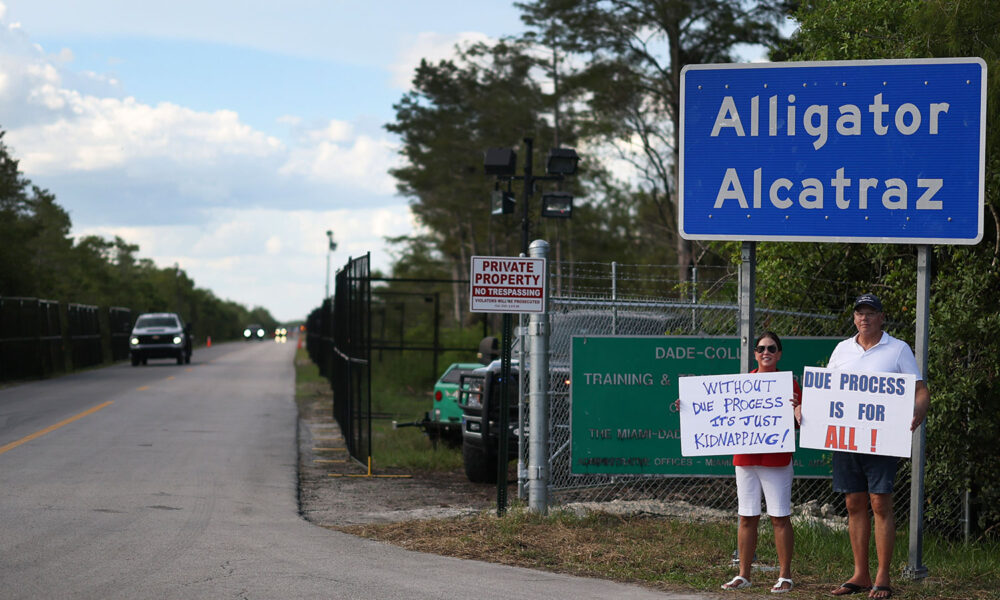It is a well-established fact that the United States has long sacrificed the health and well-being of Black, Indigenous, and Latinx communities to keep its economy running. People living in frontline communities breathe in the deadly, toxic fumes from thousands of diesel trucks and multi-mile-long diesel locomotives that pass throughout their neighborhoods, leading to nearly 9,000 premature deaths a year. Behind every shipment of “goods” is a legacy of environmental racism. The National Environmental Policy Act (NEPA) is one of the last defenses holding back the floodgates of unchecked pollution and ecological degradation.
Recently, the Trump Administration implemented a rule to weaken NEPA by shifting oversight from the White House Council on Environmental Quality (CEQ) to individual agencies, effectively diminishing the meaningful involvement of the community members most impacted by federal infrastructure projects. This is a dangerous development that threatens to worsen the impacts of environmental racism. This loss of life and cumulative environmental and public health impacts should serve as a call to action, driving solutions that yield dramatic benefits for these communities and workers, as well as global environmental and economic systems. Instead, we are witnessing the dangerous rollback of key tools that communities have relied on for decades to ensure their protection and well-being.
Take Alligator Alcatraz, an inhumane and illegal immigration detention center built in the Everglades in just days. Designed to hold up to 5,000 people, the facility stands on swampy land important to the Everglades ecosystem and Miccosukee and Seminole Tribal homelands. Alligator Alcatraz is inhumane and unjust for several reasons, including its purpose and its location; and it is a clear example of the relevance and importance of NEPA’s protections. For example, in August, a judge granted a preliminary injunction to stop any additional construction at the detention facility until the case is decided on the basis that environmentalist complainants were likely to succeed in their lawsuit arguing that the government had failed to carry out its obligations under NEPA.
What is NEPA and why should we care?
Passed in 1970, NEPA is a tool communities have utilized to push back against harmful federal projects. It requires government agencies to study how their actions will impact the environment and public health (e.g., increases in air pollution from diesel emissions, stormwater runoff, risks to endangered species, and tribal cultural sites) and then share that information with the public. Before a federal agency determines whether to approve or reject a project, NEPA requires the agency to first consider the health, environmental, and economic impacts of that decision. Picture a rural town next to a wetland, or a coastal neighborhood threatened by a new highway or power plant. NEPA steps in as a three-tiered guardian, making sure federal projects don’t steamroll these communities without scrutiny.
Whether it’s a new highway, port expansion, or industrial site, NEPA allows the people to learn about what’s coming, speak up, and demand better. Communities have used NEPA to challenge projects that increase pollution, displacement, and environmental harm, especially within Black, Brown, and working-class neighborhoods.
How NEPA works
The amount of environmental review conducted under NEPA depends on what the federal government is proposing and how that action will affect the environment, health, and the economy. Depending on the project’s scale, federal agencies may be required to do the following:
Categorical Exclusions (CE): Apply to project types that are predetermined by the agency to have no significant environmental impact, like repainting a bridge or maintaining road repairs, the federal agency can proceed with less oversight if it has designated that activity under a CE.
Environmental Assessment (EA): If a project might pose more than trivial harm, like widening a highway, an EA is required. It’s a focused analysis of impacts and alternatives. If no serious issues are identified, the agency issues a Finding of No Significant Impact (FONSI), and the project moves forward. If significant potential risks are found, the project moves to the next level: preparation of an environmental impact statement.
Environmental Impact Statements (EIS): For major actions like new highways, ports, or pipelines, an EIS is typically required. It examines environmental effects (air, water, wildlife, climate, public health), compares reasonable alternatives (could the project be built elsewhere or in another way) and incorporates public input through hearings and comment periods. This is where affected communities can bring evidence, stories, and science to demand safer or cleaner options.
NEPA has repeatedly resulted in improvements to proposed projects, and in some cases highlighted community and environmental concerns serious enough to convince federal agencies to reconsider them entirely. In January 1971, the Cross‑Florida Barge Canal was canceled after the CEQ’s review exposed massive ecological harm, forcing President Nixon to backtrack despite intense political pressure in Florida. A few years later, community groups in Maryland sued the Atomic Energy Commission for skipping an Environmental Impact Statement on the Calvert Cliffs nuclear plant; the court ruled in their favor, pausing licensing until NEPA standards were met.
More recently, the Bureau of Land Management issued a Supplemental EIS in April 2024 for Alaska’s controversial Ambler Road, ultimately adopting a “no action” option that halted the project, thanks to tribal and environmental advocacy. Each case from wetlands and nuclear plants to remote roads demonstrates how NEPA demands transparency, alternatives, and meaningful public participation in protecting communities, ecosystems, and cultural heritage.
It should be noted that while ultimately the government is not required to choose a project solely based on its being the most environmentally sound alternative, the NEPA process does require transparency and consideration of potential negative and positive impacts in the decision-making process. Community participation via the comment process provides the opportunity to improve a project that could potentially harm communities. In fact, a recent NEPA study concluded that the ability for communities to provide feedback on projects has shaped the results of government decisions. This level of meaningful involvement is exactly what the Trump administration is planning to remove from the process.
Environmental justice impacts
The fight against toxic pollution caused by the freight transportation system is more than an environmental issue. It’s a matter of life and death for communities of color and stems from a legacy of environmental racism. Many white and wealthy Americans are protected by a “pollution privilege,” while the enduring impact of racially discriminatory siting decisions and zoning policies that leave Black, Brown, immigrant, and Indigenous communities trapped in what community advocates and health professionals call “diesel death zones,” disproportionately bearing the brunt of these intersecting emergencies. Discriminatory housing and land-use policies mean major highways and trucking corridors often run right through Black and Brown neighborhoods, leaving higher asthma rates and other serious health problems in their wake. NEPA offers the opportunity to analyze a federal project’s impact on communities.
Solutions
Advocates and public health experts have spotlighted diesel trucks on highways, major roads, and ports as some of the most dangerous sources of pollution threatening frontline communities. The good news is that technology is catching up, but NEPA is a tool that has given communities a platform to push for technologies and land uses that are more equitable.
Take the United States Postal Service (USPS) electric vehicle fight. Their initial EIS proposed only 10% zero‑emission vehicles, leaving 90% gas-powered, and called for a mixed fleet well into the next decade. That didn’t sit well with communities and environmental groups across 16 states. Through NEPA’s transparent review process, and multiple public comment proceedings, the Postal Service was convinced to boost its commitment to 62% battery-electric vehicles for its new fleet of over 106,000 trucks. This is a great example of how NEPA provides a unique opportunity to bring the benefits of innovation to the people who need it most.
Call to action
This rollback isn’t a minor tweak; it is a direct assault on democracy. By removing clear rules, it leaves federal decisions to the whims of individual agencies, allowing more pollution, climate damage, and community harm to proceed unchecked. Failure to act is not only negligent; it also renders us complicit in destroying our most vulnerable communities. You can act today by urging your members of Congress to protect the National Environmental Policy Act.
We’re at a critical juncture. This isn’t just about policies or politics, it’s about environmental justice, about ensuring that all communities regardless of race, gender, sexual orientation, age, culture, ability, nationality, or income, have the right to breathe clean and healthy air in their communities. We must protect and work to strengthen NEPA now, so that we are able to protect lives today, and for future generations.

